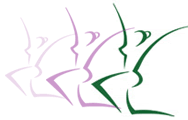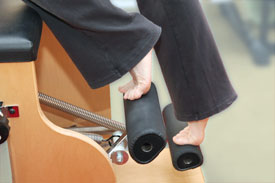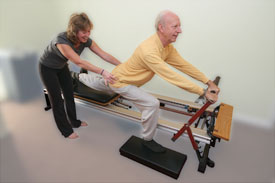Debra Stackwood is a qualified Pilates teacher offering Pilates classes in Arundel and West Sussex.
WHY CHOOSE PILATES?
Pilates has become an increasingly popular form of exercise over the last twenty years. Its emphasis on ‘core’ muscles has led it to be regarded as good for your back. This emphasis on ‘core’ muscles is what distinguishes it from other forms of exercise. However, in the UK Pilates is mainly taught as floor exercises in large classes.
Mat-work classes are not always a good way to learn Pilates. Large classes and variable instructor experience mean that they are not always the best choice for beginners or even intermediates. You may have a long history of injuries and ongoing conditions, as may the people on the neighbouring mats. There isn’t the scope in a class to have an understanding of every individual and to tailor the workout accordingly. Class work, means just that: you exercise according to the dictates of the class, not your own needs. Classes are based on verbal instructions. There isn’t the time to go round and check that each individual is doing the exercises correctly. When you first start Pilates this can be a problem. Many people have difficulty understanding what their core muscles are and what they should be doing with them. This isn’t because you are unfit, it’s because core muscles are different from other muscles. They have a particular way of working which can be difficult to grasp if you don’t know what to look for.
Joe Pilates, the founder of Pilates, taught his exercises on specially built apparatus on a 1:1 basis. My clinic has the same apparatus and the same emphasis on individual teaching. The only difference is that I am also an Osteopath. As an Osteopath my understanding of the musculo-skeletal system and the things that can go wrong with it is much deeper than someone qualified only in Pilates.

PROBLEM SOLVING
I don’t think anyone has ever arrived at my Arundel Pilates clinic without a goal in mind. Goals can range from wanting to go back to everyday activities pain free, to wanting to learn to ski at the age of fifty. It doesn’t matter what your goal is, the Pilates apparatus is highly adaptable and can be used to mimic the patterns of movement needed for a particular activity or sport.
The training that I received from both Polestar Pilates and the APPI (Australian Physiotherapy and Pilates Institute) was led by physiotherapists. My training was focused on problem solving. It focused on how to take you from where you are, to where you want to be, in other words, your goal. At your first session we will discuss what’s brought you here and what you want to gain from doing Pilates. I will ask questions about your general health, other medical care you are receiving or medication you are taking. I will record your answers and these will be kept confidential. I will then assess you by asking you to do some movements either standing or on the Pilates equipment. Then I will tell you how many sessions I think you will need.
You should feel changes in your body straight away. The equipment can deliver a carefully calibrated programme which enables a fairly quick progression through the exercises. With 1:1 sessions on the equipment you will progress quicker than you would in a mat-work class. Your body will hold onto some of the changes and discoveries that you made during the session, so that each session builds on the previous one.

HOW DO I TEACH PILATES?
My teaching is strongly influenced by Polestar Pilates. In particular the philosophy of giving people a positive movement experience. If movements feel safe, secure and comfortable, you gain confidence. Having a positive movement experience makes people want to move more. Lots of structural and biomechanical changes occur when you move in a positive way. Exercise leads to the release of endorphins or ‘happy’ hormones. The rhythmic movement of joints helps to lubricate them. Your brain gets better at co-ordination and balancing. The gradual toning of muscles and deeper understanding of your body enables you to refine movement and become more skilled at sports or activities. This applies to everyone, but for people with chronic pain it’s especially important.
The amount of pain you are in is not always an accurate measure of the degree of injury or damage present in your body. Think of when you last cut your finger on a piece of paper. It really hurt but was there much damage to your finger? When we move and it hurts, we either stop or modify the movement. If these modifications don’t correct themselves, after a while they tend to pile up causing increasingly dysfunctional movement.
Pilates is good at breaking down faulty movement patterns and replacing them with healthier ones. Pilates starts with the ‘core’ or trunk muscles and works outwards. All our big powerful muscles are either part of the core or insert onto it. If we can get these muscles to work in a balanced way, they affect not just trunk stability but also our ability to move our arms and legs in a co-ordinated and aligned way. For an example of my teaching style look at the video below.
A FLEXIBLE APPROACH
Joe Pilates died in the 1960s. After his death, Pilates was developed in different ways by several of his former students. One of the major developments was mat classes. To date there is no formal governing body worldwide or in the UK, although there are some umbrella organisations such as the Pilates Method Alliance (PMA). There is no agreed definition of the word ‘Pilates’. This makes it difficult to give a description of Pilates that would be acceptable to all teachers. However, part of the richness of Pilates is shown by the diverse number of people who have taken Joe Pilates exercises and used them both creatively and therapeutically. As an Osteopath, my goal is to keep you safe as well as taking you forward, and making the Pilates exercises fun and rewarding
Debra Stackwood – qualified Pilates teacher offering Pilates classes in Arundel and West Sussex.
Pilates, Littlehampton, West Sussex
